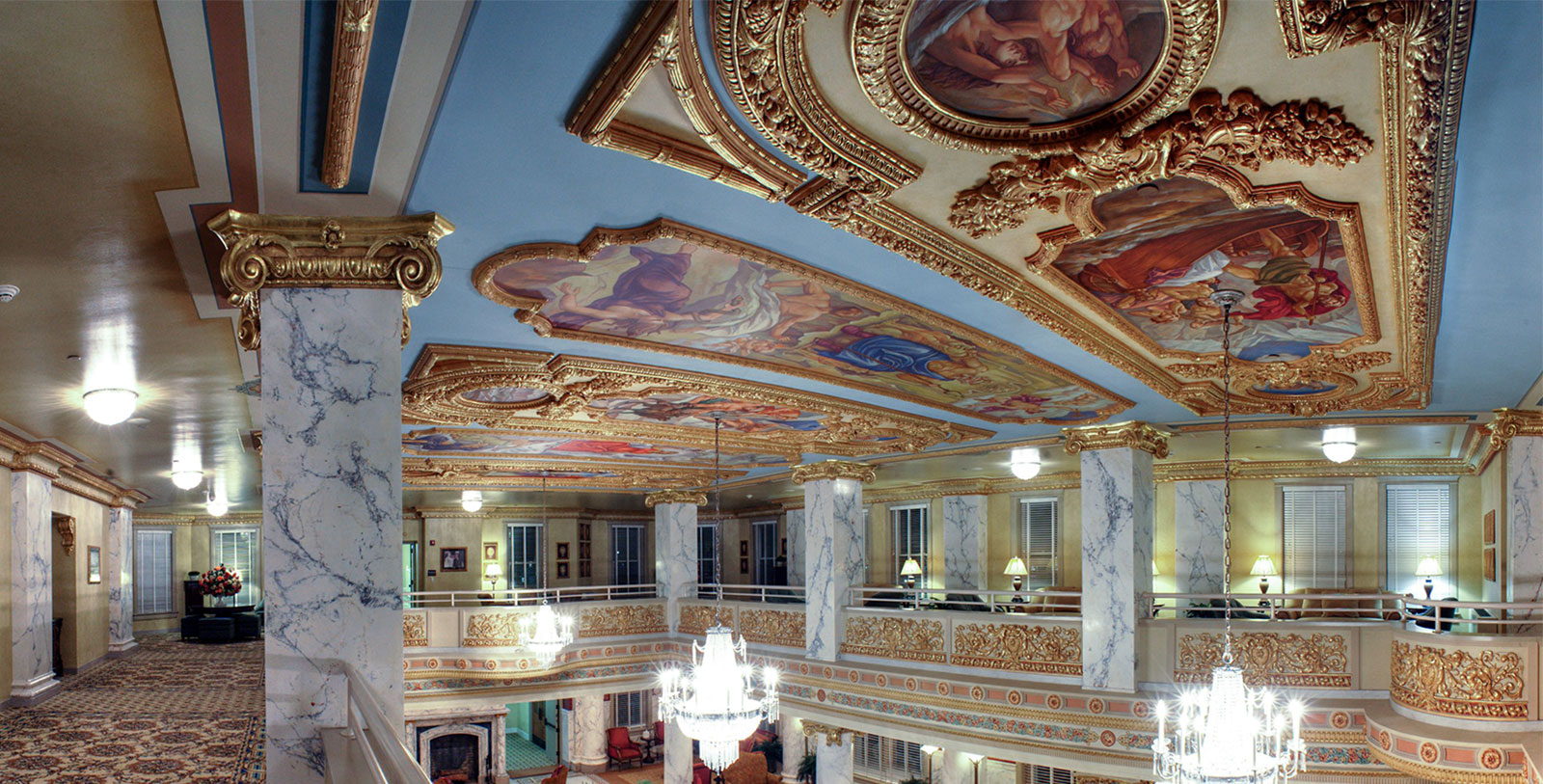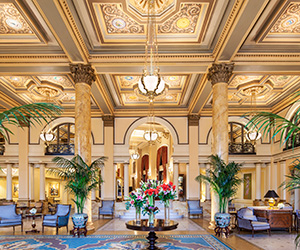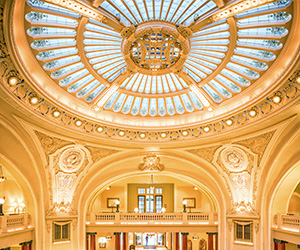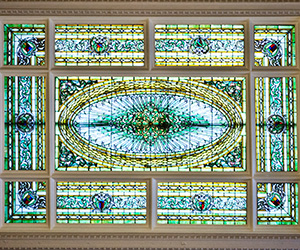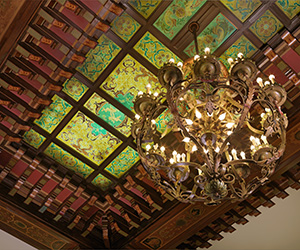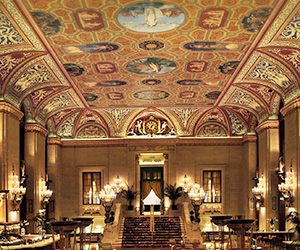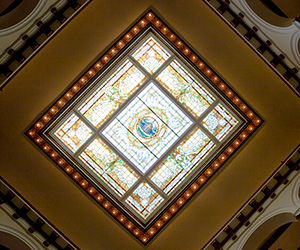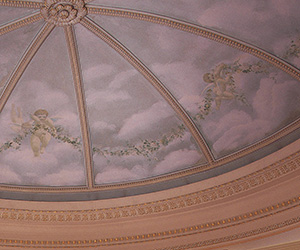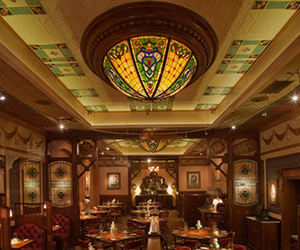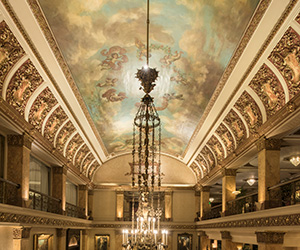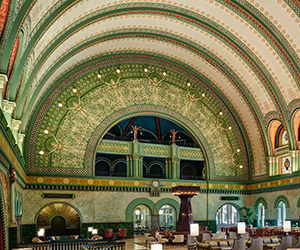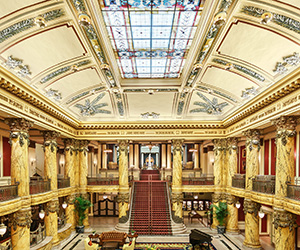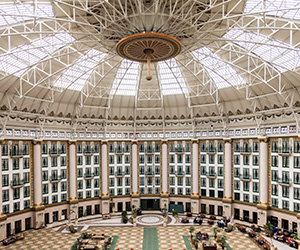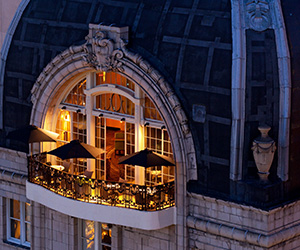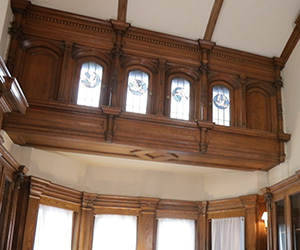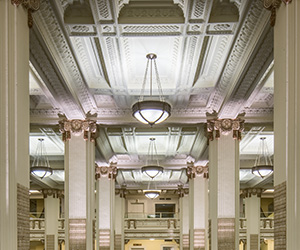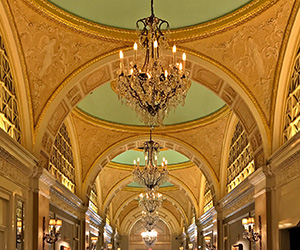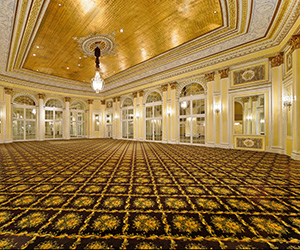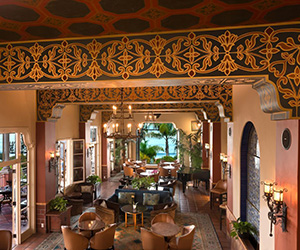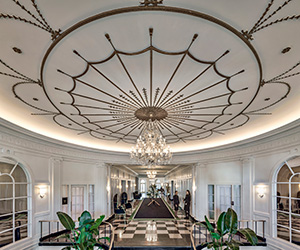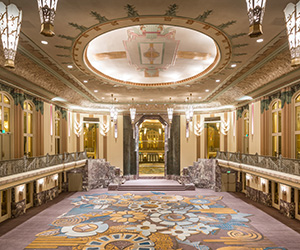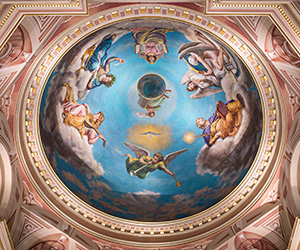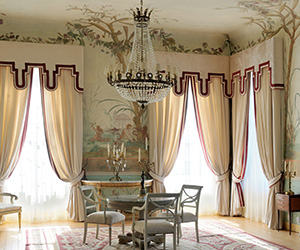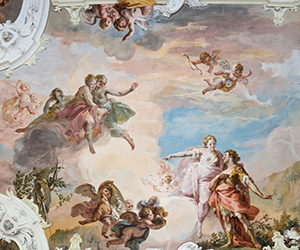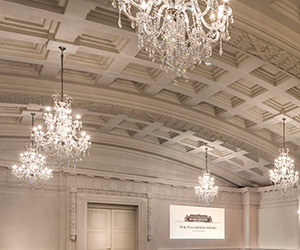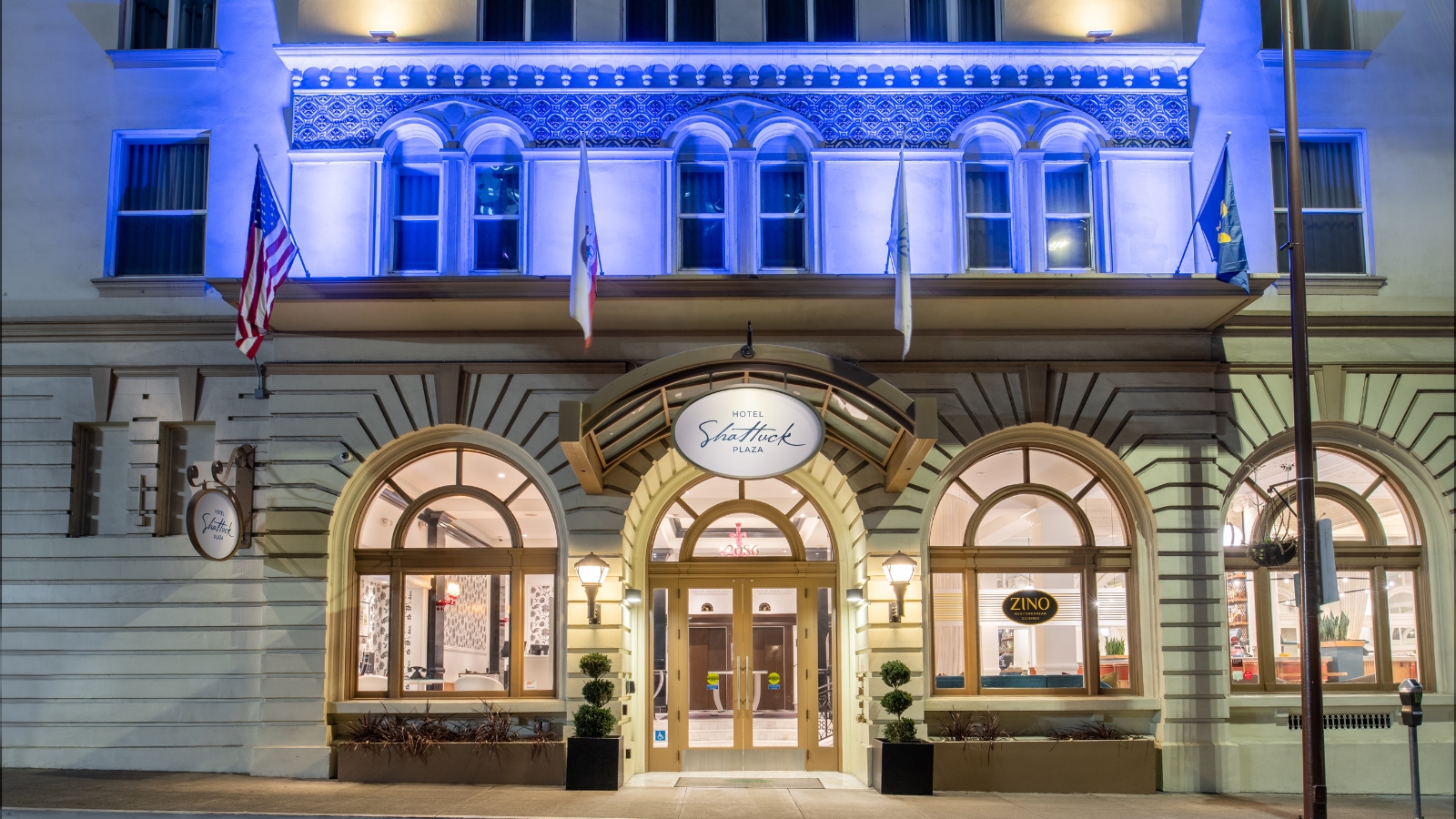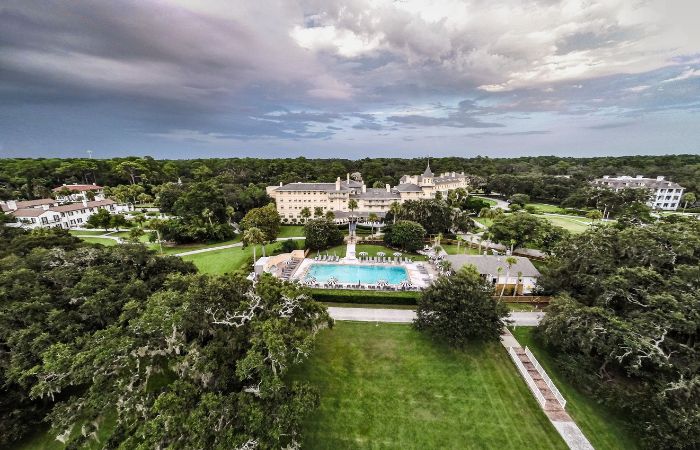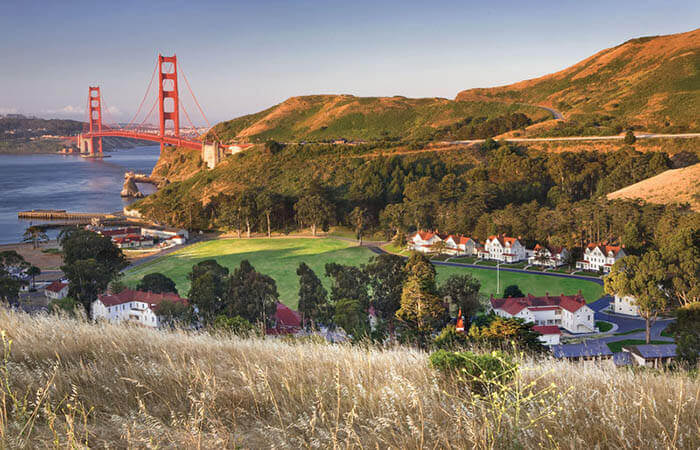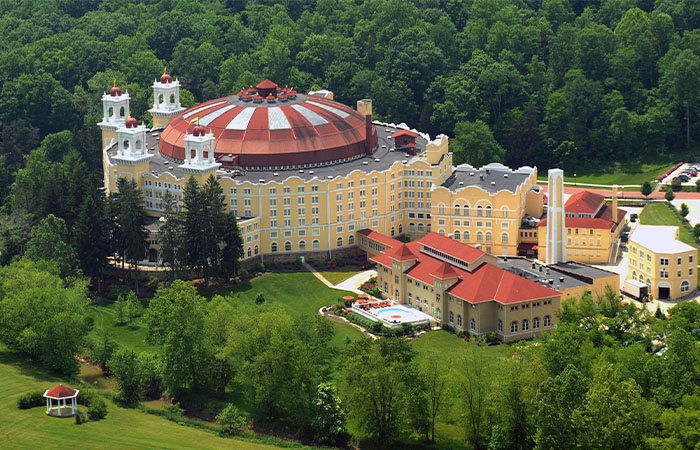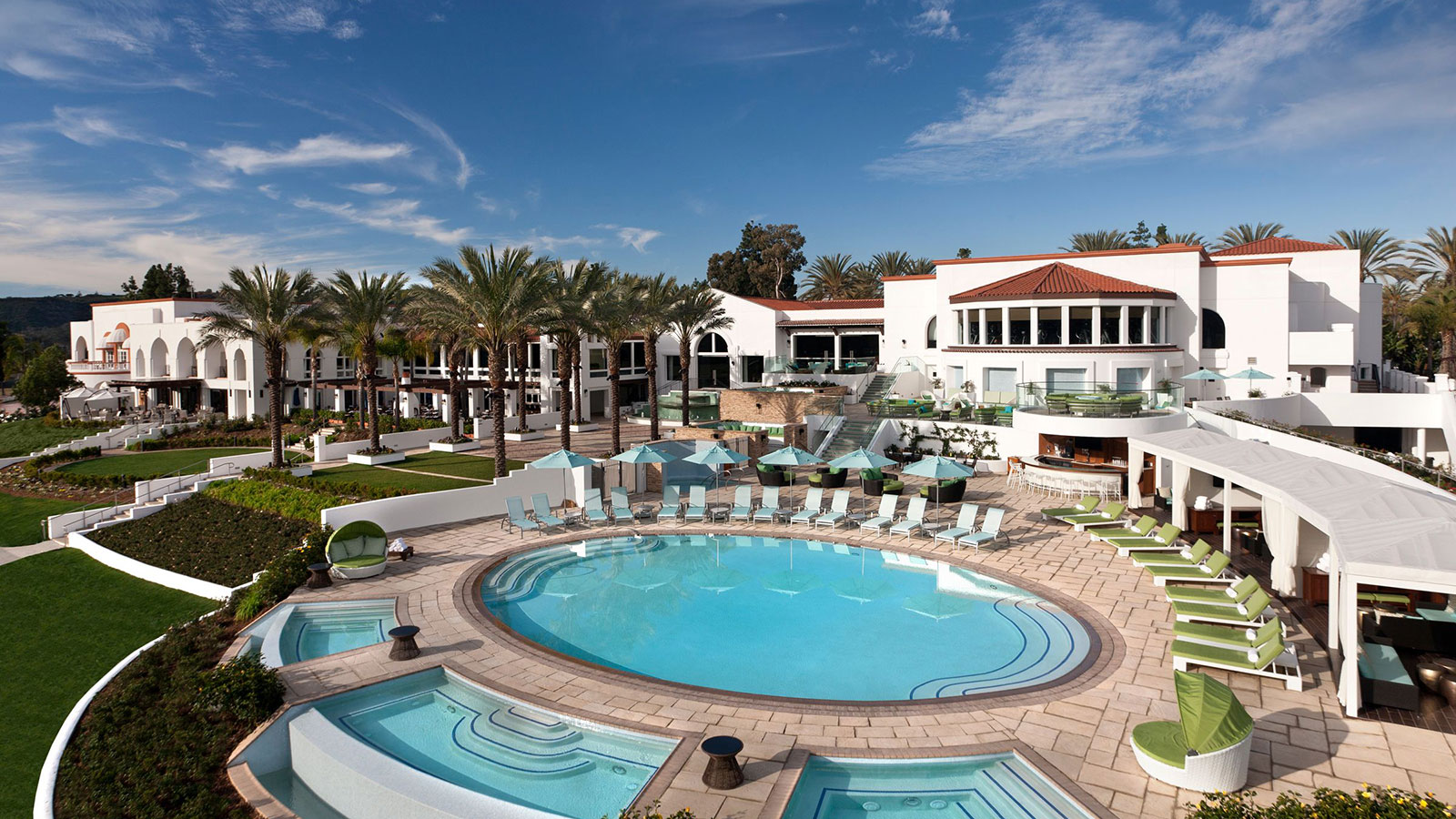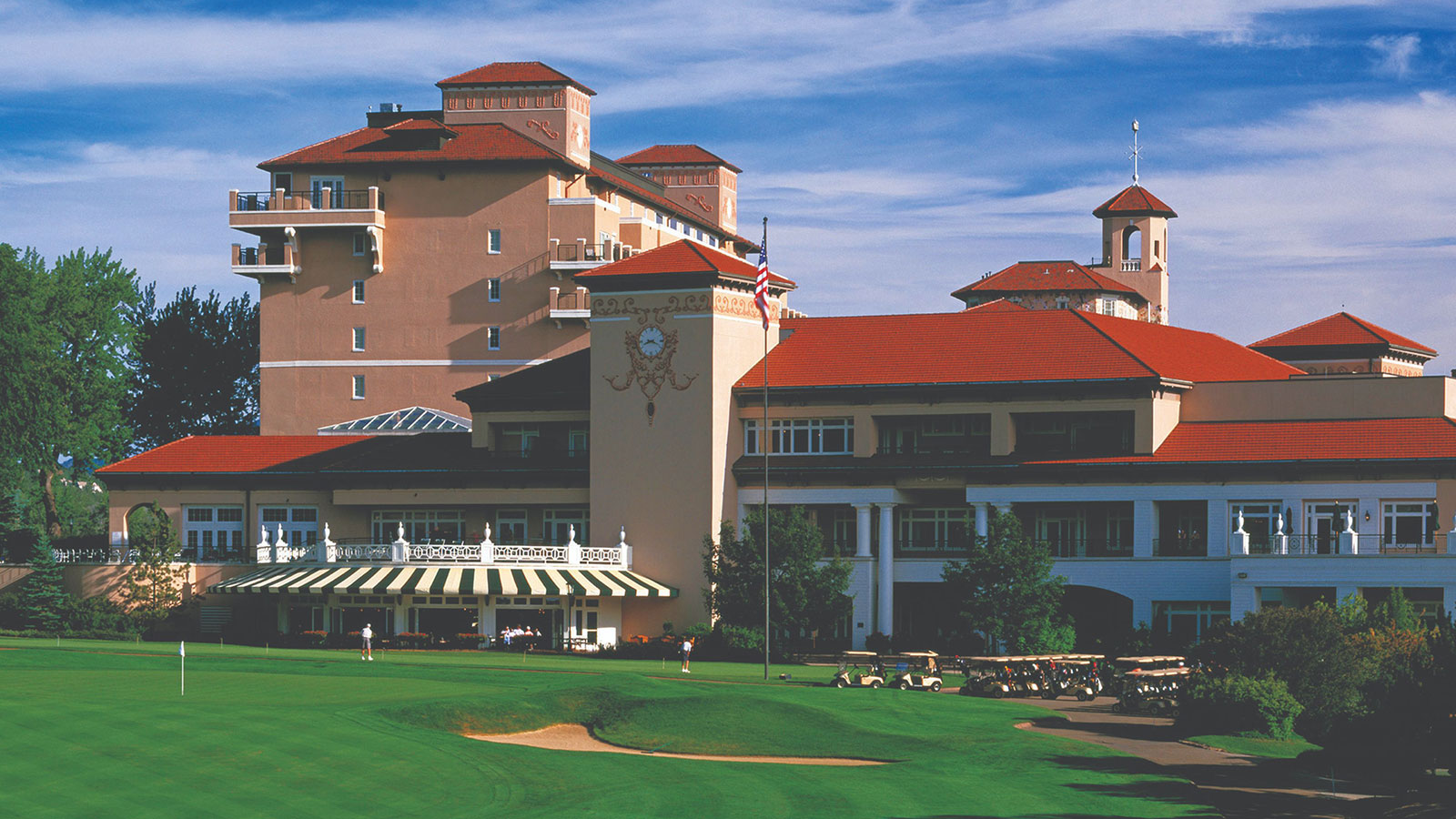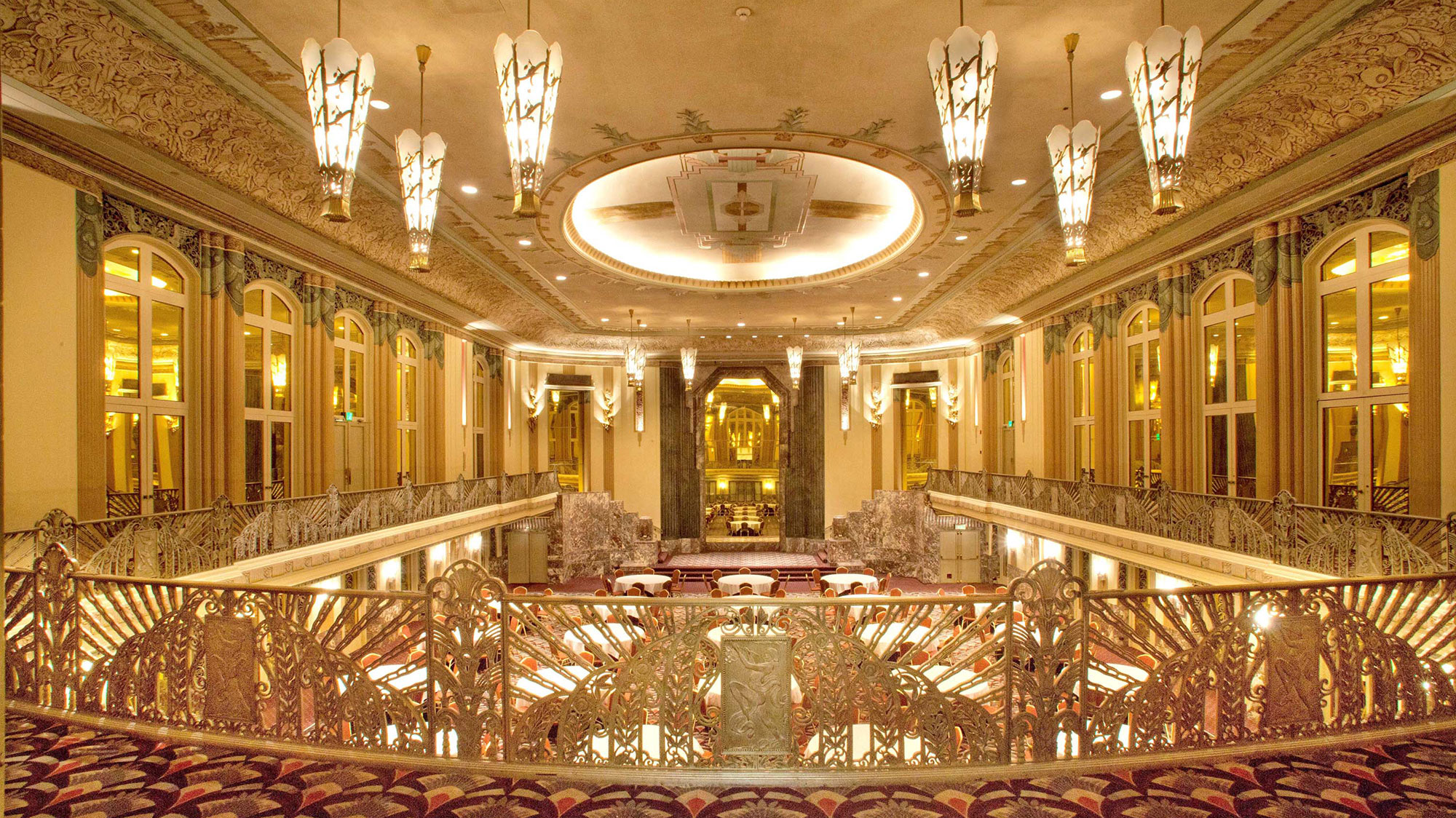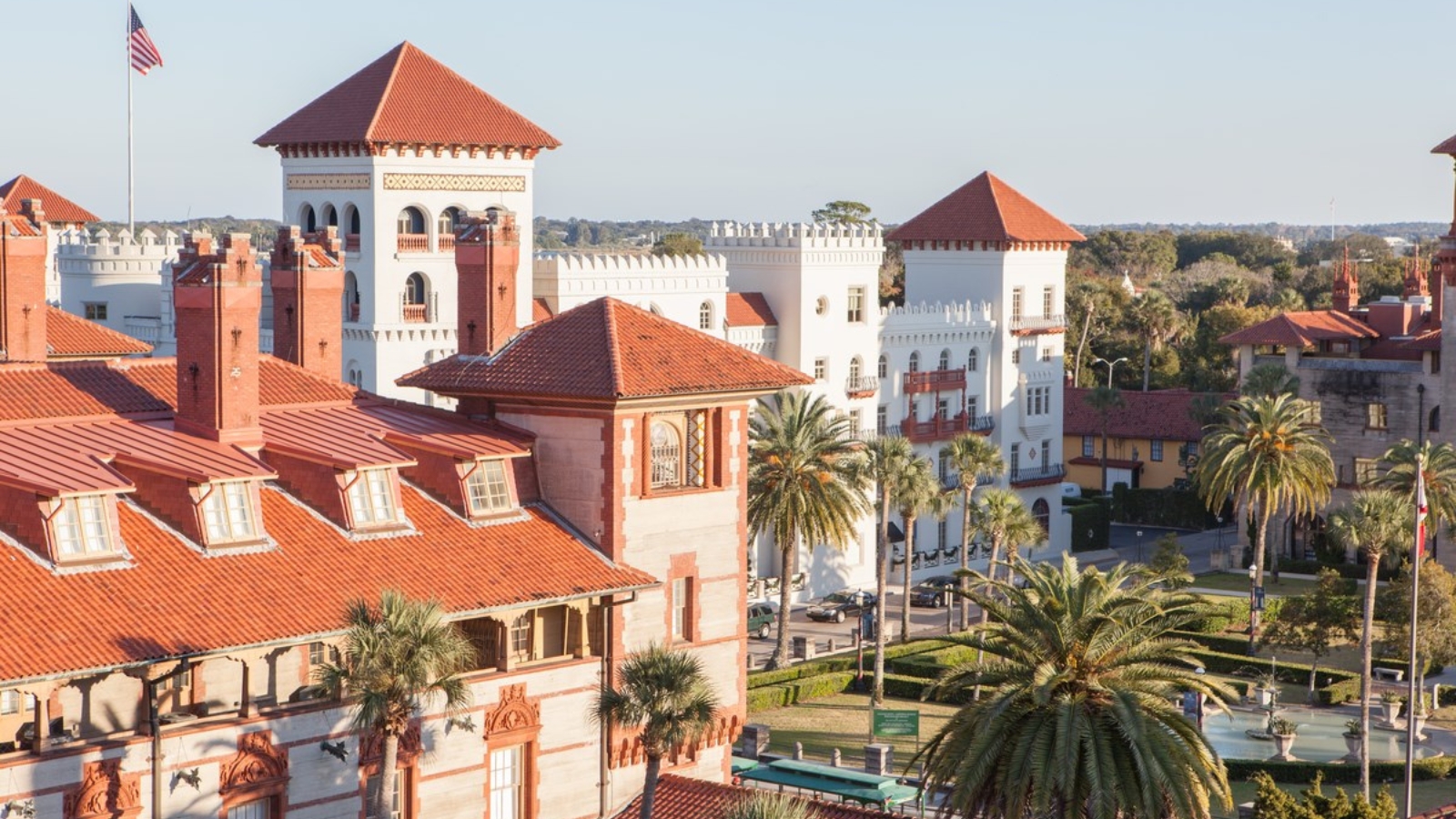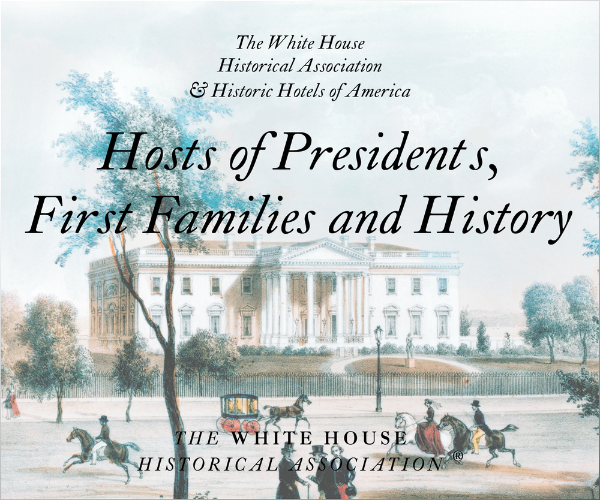Receive for Free - Discover & Explore eNewsletter monthly with advance notice of special offers, packages, and insider savings from 10% - 30% off Best Available Rates at selected hotels.
Magnificent Ceilings and Domes


Most Magnificent Ceilings and Domes
The iconic and legendary hotels inducted into Historic Hotels of America® and Historic Hotels Worldwide® are noteworthy for their grandeur and architectural significance. Guests and visitors to these hotels can see wonderful examples of the artistry, craftsmanship, and extraordinarily detailed work preserved from the past. Some of the best examples are viewed by looking up at these magnificent ceilings and domes in the public areas of these hotels including lobbies, ballrooms, and restaurants. These ornate ceilings and domes include some of the finest examples of stained-glass, painted frescoes, painted ornamental plaster, stenciled wood, and of course, gold leaf. Often, these beautiful, ornate, grand and detailed ceilings have been recognized as historically significant local or regional historic landmarks. Visit Ceilings for a complete listing of these ornate masterpieces.
Look up and see the breathtaking ceilings and domes at historic hotels across the country. Here are the 2018 Top 25 Most Magnificent Ceilings and Domes at Historic Hotels of America:
| The Willard InterContinental, Washington, DC (1818) Washington, DC The Willard's iconic lobby has a coffered ceiling that is adorned with 48 original state seals. The seals for Alaska and Hawaii reside on the back pillars of the iconic Peacock Alley. For over a century, the Crystal Room has played host to many of Washington DC’s most elegant social and corporate events. From sophisticated receptions and lavish galas, to prestigious conferences and annual meetings, the Crystal Room provides a stunning backdrop for an unforgettable event. Exuding spectacular opulence, the Crystal Room’s design motif includes mottled green columns, crystal-dripping chandeliers, ornate hand-carved gold leaf crown molding, and antique drapery. |
| French Lick Springs Hotel (1845) French Lick, Indiana The Baroque-style murals on the ceiling of the mezzanine level of the hotel are visible by just looking up from the lobby. In keeping with the area's fame for producing mineral-laced “Pluto Water” 100 years ago, the murals depict the mythological story of Pluto's World. A single mural over the main lobby shows Orpheus and Eurydice, symbols of love, in a springtime setting. This is the story of Pluto’s world, as told through a breathtaking mural containing six separate panels. The mural may look like a masterpiece that was crafted in a bygone era, though it actually was designed, painted and installed during the 2005-2006 renovation that restored French Lick Springs Hotel to its original grandeur. A group of artists from Conrad Schmitt Studios invested 1,500 hours in the planning and creation of these mural panels. In the process, Pluto’s world came to life. |
| Battle House Renaissance Mobile Hotel & Spa (1852) Mobile, Alabama Inside the lobby of the Battle House is a stunningly beautiful dome that is over 42 feet tall and 63 feet wide. The Tiffany-style glass in the dome features fleur-de-lis designs, in keeping with the city's history, as the true birthplace of Mardi Gras. The painting technique used to depict these rulers in the lobby ceiling is called Trompe-l'œil. It is an art technique involving extremely realistic imagery in order to create the optical illusion that the depicted objects really exist, instead of being just two-dimensional paintings. In refurbishing the dome from 2004 to 2006, master plaster artists were brought in to work with their apprentices and make molds of all the design elements in the ceiling. The glass ceiling designs were carefully repaired and more than 95 percent of the glass is original to the 1908 construction. |
|
| The Menger Hotel (1859) San Antonio, Texas The Victorian lobby reflects the 1909 remodeling, designed by noted San Antonio architect Alfred Giles. Giles transformed the simple utilitarian space into a grander, neoclassical style which was popular at the time. The oval-shaped lobby is dominated by eight Corinthian columns. The original columns were cast iron and encircles the redesigned columns ornamented with festoons, garlands, modillions, and painted to resemble stone. The leaded skylight was added as part of the 1909 alterations, as was the decorative tile floor which extended into the Colonial Room Restaurant. Many of the pieces of furniture in the lobby are believed to have been purchased by William Menger on his frequent buying trips to New York and Europe in the 1860s. |
|
| The Peabody Memphis (1869) Memphis, Tennessee The ornate stained glass skylight and carved wood ceiling in The Peabody’s Grand Lobby is one of the signature characteristics of the hotel, measuring in at 32 feet high and 3,100 square feet in total. The ceiling dates back to the opening of the current Peabody, built in 1925. The hotel was designed by noted Chicago architect Walter Ahlschlager, who also designed the Hilton Cincinnati Netherland Plaza. The glass skylight is located in the Peabody Lobby Bar and the lobby fountain where the famed Peabody Ducks reside during the day. The Duckmaster offers daily history tours in the Grand Lobby, which highlight the ornate ceiling. A little known fact about the ceiling is that the beautiful carved wood that surrounds the stained glass is not wood as it appears, but sculpted plaster. |
|
| Palmer House®, a Hilton Hotel (1871) Chicago, Illinois The ceiling of the Palmer House has been compared to that of the Sistine Chapel of Saint Peter’s Basilica in Rome. Measuring in at 28 feet high and 50 feet by 28 feet wide, it is approximately the size of a basketball court. These 21 distinct pieces of artwork were completed in Paris in 1926 by Louis (Pierre) Rigal. Three large circular panels illustrate classic romantic scenes from Greek mythology. Depicting Aphrodite, the goddess of love; Apollo, the god of sun, music, and poetry in his pursuit of Daphne; and the god Pluto in his pursuit of Persephone. There are nine vertical paintings of the Muses where each Muse depicts a joy of life. The 16 plaster frescos that frame the ceiling are done in the style of the 15th century Della Robbia family in the colors of Wedgewood blue, cinnabar, and celadon. The paintings that adorn the ceiling were completed in 1917 in France and later installed in the hotel’s ceiling in 1927. |
|
| Capital Hotel (1873) Little Rock, Arkansas The ceiling at the Capital Hotel is 110 years old, dating from 1908 when the hotel was transformed to compete with the new hotels in the area. The project was directed by architect George Mann who had been hired in 1899 to design the Arkansas State Capitol. Mann’s design featured a two-story atrium that in addition to increasing the light, created a mezzanine with original brass railing, a colonnade and ionic columns leading out to a balcony on the front façade. The columns were meticulously modeled after the original lobby columns, a process called scagliola in which plaster is mixed with finely ground gypsum, marble dust, and glue producing a rock hard exterior that can be crafted to resemble marble. |
|
| Wentworth by the Sea (1874) New Castle, New Hampshire The original hand-painted mural on the domed ceiling is the show-stopper of SALT Kitchen + Bar in Wentworth by the Sea hotel. Painted by 19th century Portsmouth decorative muralist, Jan Ernst Hoxie, the mural features cherubs bearing garlands of flowers. The ceiling dome and mural survived the 20-year long shuttering of the historic hotel and was photographed by Yankee Magazine after the hotel’s grand re-opening in 2003 to illustrate the story of the “best places in New England to dine with a view.” The dome remained the centerpiece of the room during the extensive 2013 renovations and was the inspiration for the palette of pale blue and rose accents used in the new décor. |
|
| The Strater Hotel (1887) Durango, Colorado One of the two domes in the hotel was purchased around 1989 from a Durango Bar that was going out of business and believed to be about 60 years old. This dome was hung in the Mahogany Grille. Several years later, one of the staff was tasked with duplicating the dome that was purchased in 1989. The dome was recreated using rubbings and a color wheel. Three years later, the dome was finished and both domes are virtually indistinguishable from each other. There are also two curved ceilings in the lobby of the hotel that have a slight domed look with panels. An artisan who was in the area in 1910 worked on other landmarks in the area and had a large influence over the design and ceiling of this hotel as well. |
|
| The Pfister Hotel (1893) Milwaukee, Wisconsin The Pfister Hotel and its iconic ceilings are 125 years old. Originally built as an open skylight and later enclosed and painted white, the Pfister lobby ceiling has experienced several iterations until a new mural in the spirit and grace of the lobby’s 1893 vaulted skylight was created. The muralists painted directly onto the vaulted ceiling highlighting with hand painted gold leaf. The sky blue scene of cherubs positioned throughout the clouds is intended to recall the lobby’s original skylight. The borders of the ceiling are completed in ornamental plaster that is glazed and covered with Dutch metal lead which mimics gold leaf. |
|
| St. Louis Union Station Hotel, Curio Collection by Hilton (1893) St. Louis, Missouri Described as “Sullivanesque,” each night, watch as flowers sway, fireworks burst and other images dance around the 65 foot ceiling of the Grand Hall lobby in a state of the art 3D light show designed specifically for this St. Louis hotel. The magnificent ceilings were built in 1894 and the original artists were Healy & Millet of Chicago Color Decorations. The barrel vaulted ceiling measures 65 feet at the peak of arch. |
|
| The Jefferson Hotel (1895) Richmond, Virginia The focal point of the Palm Court at The Jefferson Hotel is the circular stained-glass that completes a majority of the room's 35- foot ceiling. Surrounding the room are 12 stained-glass windows, each vibrant design featuring The Jefferson's original logo, similar to the crest that is used today. These side-panel windows are believed to been crafted by the famous artisan Louis Tiffany. The stained-glass elements were added to the lobby following the 1901 fire which destroyed two-thirds of the original 1895 structure. The 40 foot ceiling of The Jefferson's Rotunda lobby features both a massive stained-glass skylight as well as intricately carved plaster featuring an elegant palm frond motif. |
|
| Omni Mount Washington (1902) Bretton Woods, New Hampshire Intricate Italian plasterwork, crystal chandeliers and Tiffany stained glass accents adorn the lofty Great Hall and Main Dining Room. The rustic brickwork in The Cave and acoustically perfect dome of the Conservatory, looks upward inside the historic Omni Mount Washington is nearly as pleasing to the eye as looking outward to the majestic mountain peaks that surround it. Whether guests are first wowed by the columned Porte Cochere upon arrival, or mesmerized by the subtle details of the Sun Dining Room and Grand Ballroom’s hand plasterwork, there’s no shortage of old world craftsmanship to complement this legendary grand hotel. |
|
| West Baden Springs Hotel (1902) West Baden Springs, Indiana Built in 1902, the West Baden Springs Hotel in Indiana held the record for the largest free-span dome in the world for 61 years. The sheer size of the dome makes it a historic landmark. Built in the early 1900s, the technology used to build it has influenced other great domes like the New Orleans’ Superdome, the Astrodome in Texas, and Atlanta’s Georgia Dome. Curved, wedge-shaped skylights make up the roof of the elegant domed atrium, a circular space 100 feet tall and 600 feet in diameter. Enclosed by five floors of guest rooms that overlook the space from French doors, the atrium has no other function than to amaze. Winning numerous awards and designations, this dome is one that has to be seen in person to be believed. |
|
| The Bellevue (1904) Philadelphia, Pennsylvania For over a century, The Bellevue Hotel has welcomed leaders in politics, arts, society and business from all over the world to experience the elegance and wonder of the “Grand Dame of Broad Street.” The focus on art, architecture and design was groundbreaking in its day and so many of these features can still be seen today. Perhaps none more breathtaking than the home of XIX Restaurant. The restaurant showcases two identical interiors each with 36 foot ceilings crowned with dome shaped cupolas and beautiful stained-glass skylights. The natural feel of these spaces are accented by incredibly wide French glass doors and windows that exit to four curved and stonework balconies with hand-wrought-iron. One of these spaces, the XIX Dining Room, is highlighted with a more modern interpretation of its deep rooted past, an Italian handcrafted chandelier made up of 2,848 pearl shaped facets perfectly celebrating the hotel’s location on the famed Avenue of the Arts and the patrons who frequent its performances and The Bellevue Hotel. |
|
| Castle Hill Resort and Spa (1905) Proctorsville, Vermont The castle, built in 1905, features elegant plaster cast ceilings in the library, oval dining room, private dining room, billiard room, and stairway. European craftsmen were brought over to work on the ceilings. Measuring in at 12 feet high each of the rooms has a different sized ceiling, the foyer being the largest. The original wallpaper from 1905 that is still present in the staircase matches the design on the plaster cast ceiling in the library. |
|
| The Seelbach Hilton Louisville (1905) Louisville, Kentucky Designed by W.J. Dodd of Louisville and F.M. Andrews of Dayton, Ohio, The Seelbach boasts a lavish turn-of-the century Beaux-Arts Baroque architectural style. Equally grand, the hotel interiors feature a lobby furnished with combined marbles from Italy, Vermont, and Switzerland along with mahogany and bronze in a classic Renaissance style, and a vaulted dome of 800 glass panes. Arthur Thomas, the most famous Indian painter in the world, was commissioned to decorate the lobby with huge mural paintings of pioneer scenes from Kentucky history. |
|
| The Otesaga Hotel and Cooper Inn (1909) Cooperstown, New York Visible from anywhere in the Village of Cooperstown, the dome ceiling at The Otesaga is a stunning bit of architecture. Masterfully designed by architect Percy Griffin, and built in 1909, the dome atop the stately brick hotel is one of the landmark’s most exemplary elements. Crisp white and prism-like glass creates a gleam of sunlight that beckons travelers. With its octagon shape, the structure is perched in the center of the building complementing the architecture of the resort. The dome is approximately 60 feet from the ground and 20 feet in size. |
|
| Embassy Suites by Hilton Portland Downtown (1912) Portland, Oregon The lobby ceilings are 106 years old first installed by Frank Shearer working for Tresholm Plastering in 1912 and later restored by his grandson of Shearer and Sons Plastering. The original architecture was done by the firm Gibson and Cahill. The ceiling features the logo MH which stood for the Multnomah Hotel. Named after a local Native American tribe of Wappatos (Chinooks), the classically detailed American Renaissance style building features grand staircases and crystal chandeliers in its public space. 24 marble and terra cotta columns grace the lobby and support a gilt ceiling where hotel bellman once stood at attention at each column called to assist guests with their luggage moving from column to column toward the front desk as they were called. |
|
| Fairmont Copley Plaza (1912) Boston, Massachusetts Built in 1912 the gilded lobby ceilings were designed by Henry Jane Hardenbergh and ceiling murals painted by Sunny Miller. Coffered and gilded ceiling is common in Beaux Arts style- it's a classical image that is seen in Newport Mansions and other gilded age buildings- original to the Fairmont Copley Plaza. The lobby also showcases beautiful ceiling murals, one of each side of the lobby, depicting sunrise and sunset. Peacock Alley received its name because of the constant parade of fabulously dressed socialites who made their grand entrance into the lobby. The plasterwork cameos in this hallway are originals. Featuring cherubs and mythical elements, this ceiling was completed in the classical style. |
|
| Amway Grand Plaza (1913) Grand Rapids, Michigan For nearly a century, the Pantlind Ballroom has dazzled guests with its eye-catching gold-leaf ceiling, crystal chandelier, and intricately detailed fixtures. The Pantlind Lobby ceiling is unforgettable and record breaking, covering more than 7,000 feet makes up the largest gold leaf installation in the United States. Suspended from the ceiling like radiant teardrops, three Austrian crystal chandeliers imported from Czechoslovakia set the stage for the old world charm of the original Pantlind Wing. Each chandelier weighs roughly 4,000 pounds and sends a dazzling display of light across the more than 7,000 square-feet of gold leaf domed ceiling. |
|
| The Broadmoor (1918) Colorado Springs, Colorado When the hotel was being constructed in 1917, Mr. and Mrs. Penrose brought in over 100 Italian artisans and craftsmen to complete the elaborate ceiling work seen today. John Smeraldi was the artist engaged to work on the ceiling. Smeraldi specialized in Italian Renaissance revival painting and interior design. He perfected his skills as a master painter in the Renaissance style while apprenticing in Rome. Portrayed in the painting are two dancing cherubs, one often noted for its depiction that includes reserved feet. |
|
| La Valencia (1926) La Jolla, California The original ceiling of the main building was intended to be reminiscent of Spanish Royal Crests and Medallions. The main ceiling panels, painted on plaster, were traditional repeated mosaics in a deep terra cotta. The grand “cement” cross beams were painted faux wood – intended to look heavily timbered with Spanish Crests. The room is 20 feet wide and 80 feet long. By 2011, the ceiling was in extremely poor condition due to time and proximity to the ocean. In 2014 the ceiling and room were restored to their former glamour. |
|
| The Cavalier (1927) Virginia Beach, Virginia The Cavalier's Jeffersonian inspired architecture was designed in the spirit of Monticello, with nods to locations such as Woodlawn, as well as The Lawn at the University of Virginia. The plaster ceiling in the Rotunda lobby was inspired by the ceiling in the Moses Myers House, a federal-period house dating to 1790 in Norfolk, Virginia. The Cavalier’s historic rotunda lobby ceilings have been admired since the hotel’s opening in 1927, making it 91 years old. The elaborate rosette radiating from the center of the rotunda lobby ceiling is the obvious draw for guests to the hotel, but more subtle is the enrichment of the cornice with repeated female figures holding garlands. This adds an additional layer of classical ornamentation to the intricate design of the ceiling. |
|
| Lord Baltimore Hotel (1928) Baltimore, Maryland This historic hotel boasts a beautiful ornate sculpted ceiling measuring in at 30 feet high. The gold framed trim of the ceiling has vibrant multi chromatic royal colors with beautiful alternating turquois, white and mauve rosettes. The ceiling is 24 feet by 40 feet in its entirety. An immense gold Murano glass chandelier with shiny black shades complements the original, multi-colored ornate coffered ceilings in the lobby. |
|
| Hilton Cincinnati Netherland Plaza (1931) Cincinnati, Ohio Located just off the lobby of the Hilton Cincinnati Netherland Plaza is The Palm Court. When the hotel opened in January 1931, The Palm Court was originally designed as the hotel's main lobby, the perfect gathering area for guests and visitors to the French Art Deco landmark hotel. Today, this special space is home to the hotel's three food and beverage outlets; Orchids at Palm Court (Ohio's only AAA Five Diamond restaurant), The Bar at Palm Court and The Grille at Palm Court. The great room is predominantly French Art Deco with classic Louis XV overtones exemplified in 10 high murals across the ceilings which illustrate the theme of recreation. In the background of each mural, hidden behind each character, is the distinct outline of the Carew Tower, in which the Netherland Plaza is housed. Egyptian influences appear in the pyramid shape impressed upon the ceiling and portals and the plant like wall sconces throughout the space. |
|
| Morris Inn at Notre Dame (1952) South Bend, Indiana The main building, with its famous Golden Dome, is a centerpiece of Notre Dame’s past and present located just steps from the AAA Four Diamond Hotel, the Morris Inn. This structure is actually the third building to stand on the site and was built in 1879. The Golden Dome was added to this building in 1882 and was most recently regilded in 2005. The regilding process uses only about a fist-full of gold leaf to cover the entire structure. Atop the Dome, you will find a 19 foot tall, 4,000 pound statue of Mary, the Mother of God, “Notre Dame” (“Our Lady”). With this beautiful adornment, the Main Building is 187 feet tall, making it the second tallest structure on campus after the Basilica of the Sacred Heart. The ceiling and murals inside of the Notre Dame Main Building Rotunda were painted by Luigi Gregori, a Vatican artist for Pope Pius IX. Gregori came to Notre Dame on a three-year contract with the intention of returning to Rome, but he became art director at Notre Dame in 1876 and painted the rotunda of the main building. |
|
| Tivoli Palacio de Seteais (1787) Sintra, Portugal The frescoes of Salão Nobre at Tivoli Palacio de Seteais are original from the palace’s construction in 1787. The artist of these frescoes is unknown but were inspired by the French Jean Baptiste Pillement who painted the Pillement Room. The Royal Room is original from the palace’s construction in the 18th century by the Portuguese architect José da Costa e Silva. This room reflects the romanticism of Sintra and tells a love story in the frescoes above. |
|
| DoubleTree by Hilton Hotel Dunblane Hydro (1878) Dunblane, Scotland Going down the stairs from reception, glance upwards to two large stained-glass windows, which depict ‘Jessie the Flow’r o’ Dunblane’. Our beautiful countryside setting inspired this Scottish love song by Robert Tannahill. Jessie the Flow’r o’ Dunblane ‘The sun has gane down o'er the lofty Ben Lomond, And left the red clouds to preside o'er the scene; While lanely I stray in the calm simmer gloamin', To muse on sweet Jessie, the flow'r o' Dunblane. How sweet is the brier wi' its saft fauldin' blossom, And sweet is the birk wi' its mantle o' green; Yet sweeter and fairer, and dear to this bosom, Is lovely young Jessie, the flow'r o' Dunblane. She's modest as onie and blythe as she's bonnie, For guileless simplicity marks her its ain; And far be the villain divested o' feeling, Wha'd blight in its bloom the sweet flow'r o' Dunblane. |
|
| Hilton Paris Opera (1889) Paris, France Dating back to 1889, its Eiffel style lobby in the Hilton Opera Paris and Second Empire Style covered ceiling are decorated with paintings and sculptures by the artist Charles Joseph Lameire (1832-1910). Several French movies were filmed with this magnificent backdrop over the years. |
|
| Fairmont Le Château Frontenac (1893) Québec City, Canada The original sketch for the beautiful hand painted ceiling of the Verchères Space were designed by architect William Maxwell. The ceiling includes leaf and flowering vine design embellished with cartouches and monochrome motifs. The palette includes shades of blue and green against a yellow background. Palm designs are visible on top of each columns. The original name of this space was the Palm Court and its original use was a tea room. The ceilings date back to 1924. |
|
| Grand Hotel Tremezzo (1910) Tremezzo, Italy Frescoes in the Grand Hotel, represent the scenes of the Aeneid of Virgil and scenes of heaven. The grand ceiling at this historic hotel was painted by Francesco by Francesco Conegliani, Gianbattista Tiepolo’s pupil. Giovanni Battista Tiepolo, well-known as Gianbattista Tiepolo known as an Italian painter and printmaker from the Republic of Venice. He was prolific, and worked not only in Italy, but also in Germany and Spain. |
|
| Hotel New Grand (1927) Yokohama, Japan The stucco ceiling of the banquet hall otherwise known as the Rainbow Ballroom on the second floor of the main building in the hotel has been widely acclaimed for it plaster work. These ceilings were built in 1927 by Mr. Jin Watanabe and continue to be admired today. |
|
| The Fullerton Hotel (1928) Singapore Located on the fourth floor of the hotel is Singapore’s 71st National Monument. The Straits Room is known as an exclusive enclave distinctly well-appointed for formal banquets, private receptions, seminars and press conferences. Previously used as the billiard room of the prestigious Singapore Club, its lofty height, unique coffered ceiling, Singapore’s only barrel-vaulted example and crystal chandeliers are simply magnificent. Both the ceiling and wall motifs are original design elements from 1928 that were retained when the magnificent Fullerton Building was restored in 1997 into a luxury hotel. The ceiling is 90 years old and was sculpted by Cavaliere Rudolfo Nolli, an Italian sculptor and architect from Lombardy, who worked mainly in Southeast Asia during the first half of the 20th century. |
In addition to the above, here are other noteworthy and magnificent ceilings and domes at Historic Hotels Worldwide: Read all our Top 25 lists:
Top 25 Most Haunted Historic Hotels
Top 25 Most Magnificent Gingerbread Displays
Top 25 Historic Hotels for a Romantic Proposal
Top 25 Most Magnificent Gardens Top 25 Most Magnificent Ceilings and Domes























